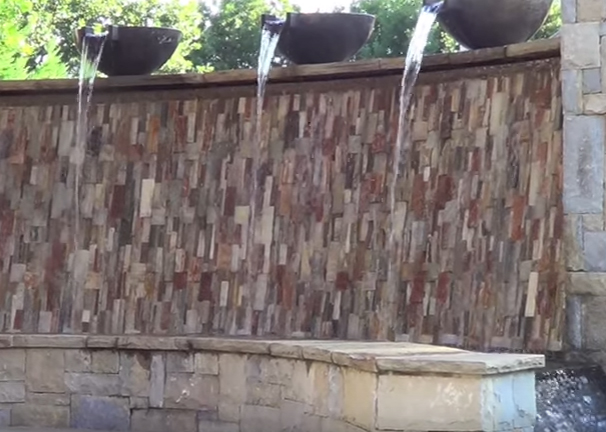#25: Water Wall

In concept, water walls are pretty straightforward: You pump a bit of water to the top of a structure and set up a weir or spillways or a system of emitters to release water so that it moves down the face of the wall the way you want it to flow.
In actuality, however, water walls are much more complicated than that. In fact, there are lots of things that can go wrong with them if you don’t carefully think things through and anticipate the kinds of results that will make your clients happy in the long run. I hit the highlights of that process in the video linked below, but let’s dig a bit deeper here.
First, it’s essential to set these features up with a system that allows you to regulate the flow to suit different moods. In the project such as the one shown here, for example, the bowls on top of the wall and the wall itself should be able to function independently. That way, if the space in front of the feature is to host a nice dinner party, the bowls and their higher level of noise can be turned off, allowing the gentler splashing of the water over the irregular slate surface to take the leading auditory role.
In addition, this sort of variable flow control (we used variable-speed pumps here) also helps when the wind rises: The flow from the bowls could end up just about anywhere in a good, stiff breeze, but the more compact flow dribbling down the wall itself will pretty much stay where it belongs unless the blow approaches gale force – in which case shutting the system down completely would seem the best idea.
Sound management is a related issue: The danger with any system in which water drops from one level to another has to do with creating monotony – a sound that never varies, never modulates and invariably starts to get on peoples’ nerves even if they’re unaware of what’s happening. Breaking the flow down the irregular surface of this wall was a big help here: It creates undertones that keep the dominant sound of water flowing from the bowls from becoming overbearing.
If you watch through to the end of the video, you’ll see that lighting is another factor that bears consideration: The sound will always be nice, but it would be a shame to let the water wall’s visual effectiveness drop off after sunset. In this case, uplighting from the basin works beautifully, highlighting the flow of the water as it dances on the irregularly cut pieces of slate. The bowls are lit from above, but the uplights also catch the downward flows and help make the whole composition come to life after dark.
More and more clients are interested in water walls these days. Knowing a bit about their complex dynamics is the key to delivering systems your clients will value far into the future.
To see the water wall discussed in this text, click here.
Mike Farley is a landscape designer with more than 35 years of experience and is currently a designer/project manager for Claffey Pools in Southlake, Texas. A member of Genesis 3’s Society of Watershape Designers since 2012, he holds a degree in landscape architecture from Texas Tech University and has worked as a watershaper in both California and Texas.










